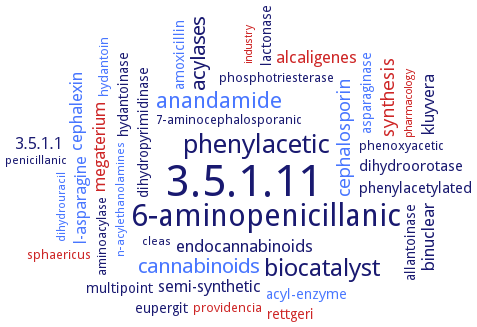3.5.1.11: penicillin amidase
This is an abbreviated version!
For detailed information about penicillin amidase, go to the full flat file.

Word Map on EC 3.5.1.11 
-
3.5.1.11
-
6-aminopenicillanic
-
phenylacetic
-
biocatalyst
-
anandamide
-
acylases
-
cannabinoids
-
cephalosporin
-
synthesis
-
binuclear
-
alcaligenes
-
cephalexin
-
megaterium
-
endocannabinoids
-
semi-synthetic
-
3.5.1.1
-
kluyvera
-
l-asparagine
-
dihydroorotase
-
phenylacetylated
-
allantoinase
-
dihydropyrimidinase
-
lactonase
-
amoxicillin
-
rettgeri
-
eupergit
-
multipoint
-
acyl-enzyme
-
asparaginase
-
hydantoinase
-
phenoxyacetic
-
aminoacylase
-
7-aminocephalosporanic
-
phosphotriesterase
-
sphaericus
-
hydantoin
-
providencia
-
n-acylethanolamines
-
penicillanic
-
dihydrouracil
-
cleas
-
pharmacology
-
industry
- 3.5.1.11
-
6-aminopenicillanic
-
phenylacetic
-
biocatalyst
- anandamide
- acylases
- cannabinoids
- cephalosporin
- synthesis
-
binuclear
- alcaligenes
- cephalexin
- megaterium
-
endocannabinoids
-
semi-synthetic
-
3.5.1.1
-
kluyvera
- l-asparagine
- dihydroorotase
-
phenylacetylated
- allantoinase
- dihydropyrimidinase
- lactonase
- amoxicillin
- rettgeri
-
eupergit
-
multipoint
- acyl-enzyme
- asparaginase
- hydantoinase
-
phenoxyacetic
-
aminoacylase
-
7-aminocephalosporanic
- phosphotriesterase
- sphaericus
- hydantoin
- providencia
- n-acylethanolamines
-
penicillanic
- dihydrouracil
-
cleas
- pharmacology
- industry
Reaction
Synonyms
ACPGA001 PGA, AfPGA, alpha-acylamino-beta-lactam acylhydrolase, amidase, amidohydrolase, ampicillin acylase, AuAAC, benzylpenicillin acylase, BmPGA, Eca3205, KcPGA, maPGA, More, novozym 217, PA, PAC, penicillin acylase, penicillin amidase, Penicillin amidohydrolase, penicillin G acylase, Penicillin G amidase, Penicillin G amidohydrolase, penicillin V acylase, Penicillin V amidase, penicillin-G acylase, PGA, PGA650, PVA, semacylase, Sm-PVA, YxeI
ECTree
Advanced search results
Source Tissue
Source Tissue on EC 3.5.1.11 - penicillin amidase
Please wait a moment until all data is loaded. This message will disappear when all data is loaded.
-
51 g/l of casein hydrolyzed with Alcalase and 2.7 g/l of phenylacetic acid (PhAc), the following carbon substrates are tested, individually and combined: glucose, glycerol, and lactose (present in cheese whey). Glycerol and glucose are effective nutrients for the microorganism growth but delay the penicillin G acylase production. Cheese whey always increases enzyme production and cell mass. However lactose (present in cheese whey) is not a significant carbon source for Bacillus megaterium. Phenylacetic acid, amino acids, and small peptides present in the hydrolyzed casein are the actual carbon sources for enzyme production. Replacement of hydrolyzed casein by free amino acids, 10.0 g/l, leads to a significant increase in enzyme production (approximately 150%), with a preferential consumption of alanine, aspartic acid, glycine, serine, arginine, threonine, lysine, and glutamic acid. A decrease of the enzyme production is observed when 20.0 g/l of amino acids are used. Using the single omission technique, it is shown that none of the 18 tested amino acids is essential for enzyme production. The use of a medium containing eight of the preferentially consumed amino acids leads to similar enzyme production level obtained when using 18 amino acids. Phenylacetic acid, up to 2.7 g/l, does not inhibit enzyme production, even if added at the beginning of the cultivation

additional information
-
overproduction of penicillin G acylase from Alcaligenes faecalis in recombinant Escherichia coli strains is optimal with 45 g/l of dextrin, and about 43385 and 79880 U/l for the highest enzyme activities are obtained in batch cultivations of shaken flasks and a 3.7 l bioreactor, respectively. The maximum yield of the active enzyme obtained is about 40% of total soluble proteins

additional information
-
optimization of medium and growth conditions for enhanced enzyme production by strain MARC-0103. Enzyme production is increased by addition of cheese whey, CaCl2, FeCl3, and Na2SO4, but not by CaCO3 and MgCl2

additional information
-
production of extracellular and mycelia-associated maPGA with Mucor griseocyanus H/55.1.1 by surface-adhesion fermentation using Opuntia imbricata, a cactus, as a natural immobilization support, 2126.50 IU/l after 48 h and 755.33 IU/l at 60 h. The immobilized PGA shows higher activity per unit volume, better operational stability, and easier synthetic applications, method optimnization and evaluation, overview

additional information
Mucor griseocyanus H/55.1.1
-
production of extracellular and mycelia-associated maPGA with Mucor griseocyanus H/55.1.1 by surface-adhesion fermentation using Opuntia imbricata, a cactus, as a natural immobilization support, 2126.50 IU/l after 48 h and 755.33 IU/l at 60 h. The immobilized PGA shows higher activity per unit volume, better operational stability, and easier synthetic applications, method optimnization and evaluation, overview
-



 results (
results ( results (
results ( top
top






